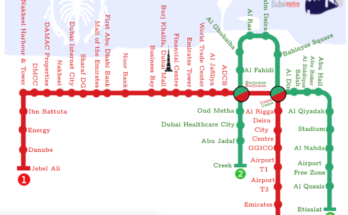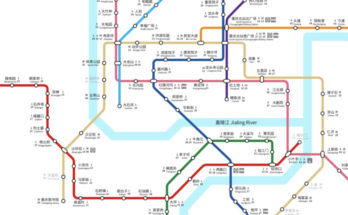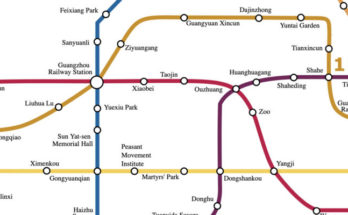Nagoya’s subway dates from 1958. It’s Japan’s third subway system, after Tokyo and Osaka. Includes 6 lines that intersect and connect to rail links and bus terminals such as Meitetsu Railways, JR, Kintetsu Railways and the Linimo maglev train. These 6 lines are: Higashiyama, Meijo, Meiko, Tsurumai, Sakuradori and Kamiida.
Nagoya’s Subway is the most convenient way of getting around Nagoya for foreign people. All the lines are color coded and most parts of the system are bilingual, easy to understand and navigate for non japanese speakers. By subway there’s access to most Nagoya’s attractions.
- Lines: 7
- Stations: 83
- Passengers/day: 1,2 millions
- Website: http://www.kotsu.city.nagoya.jp/
- Length: 89.1 km (55.4 mi)
- Map: Download
It is operated by Transportation Bureau City of Nagoya
Lines and stations
The color code lines include phisical lines
- Yellow line. Line 1 or Higashiyama Line. It’s 20.6 km (12.8 mi) long and has 22 stations.
- Purple line. Includes Line 2 or Meijō Line. It’s 8.9 km (5.5 mi) long and has 12 stations. And also Line 4, with 17.5 km (10.9 mi) and 17 stations.
- Purple & white. Line 2 or Meikō Line. It’s 6.0 km (3.7 mi) long and has 7 stations.
- Blue Line. It’s the Meitetsu Inuyama Line. 21.4 km (13.3 mi) long and 13 stations. Line 3 or Tsurumai Line, 20.4 km (12.7 mi) and 20 stations. Meitetsu Toyota Line, 15.2 km (9.4 mi) long and 8 stations. Meitetsu Mikawa Line, 1.4 km (0.87 mi) long and 2 stations.
- Red Line. It’s Line 6 or Sakura-dōri Line. 19.1 km (11.9 mi) long and 21 stations
-
Pink Line. It’s Meitetsu Komaki Line, 18.3 km (11.4 mi) long and 13 stations. Another Meitetsu Komaki Line 2,3 kms extension with 2 more stations.
Line 7 or Kamiiida Line, 0.8 km (0.50 mi) long with 2 stations. - Adult costs ¥200
- Child costs ¥100
- Adult costs ¥230
- Child costs ¥120
- Adult costs ¥260
- Child costs ¥130
- Adult costs ¥290
- Child costs ¥150
- Adult costs ¥320
- Child costs ¥160
The Meijo line is a loop since October 2004 and connects the major stations of Kanayama, Kamimaezu, Motoyama & Yagoto.
Schedule and frecuency
Most lines start at 05:00am and finish about 00:00 am.
Fares and tickets
Prices on the Nagoya subway start from 200 yen for 1 zone adults with a maximum fare of 320 yen for 5 zones adults. It’s possible to buy one-day passes for a day of unlimited rides on city buses and the subway (which costs ¥850 for both bus and subway, or ¥740 for just the subway).There is also the Donichi Eco Kippu ticket (¥600), which allows unlimited rides on city buses and the subway on weekends, public holidays, and the eighth of each month (Environmental Conservation Day).
The Yurika pre-paid card.
-
Zone 1
-
Zone 2
-
Zone 3
-
Zone 4
-
Zone 5
Curious facts
Nagoya Station is the world’s largest train station by floor area
There is a car only for woman during rush hours, 8am-9am, on the Higashiyama Line through Sakae, Fushimi to Nagoya Station.
Hatchii is Nagoya Municipal Subway’s mascot, and his first appearance was in August 1, 2002.
Connection to the airport
Nagoya’s airports are Chūbu Centrair International Airport (NGO), on the artificial island off shore of Tokoname, and Nagoya Airfield (Komaki Airport, NKM).
There are high speed Meitetsu express trains to Chubu International Airport from Nagoya Station (30 mins), Kanayama Station (25 mins) and Jingu-mae.



